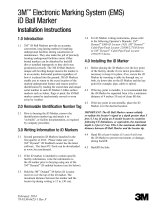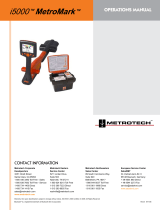3M Full-Range Marker 1253, EMS 9 ft Extended Range, Wastewater Operating instructions
- Type
- Operating instructions
This manual is also suitable for
- Full-Range Marker 1248-XR/iD, 8 ft Range, General Purpose
- Full-Range Marker 1250, EMS 9 ft Extended Range, Telephone
- Full-Range Marker 1250-XR/iD, 8 ft Range, Telephone
- Full-Range Marker 1251, EMS 9 ft Extended Range, Power
- Full-Range Marker 1251-XR/iD, 8 ft Range, Power
- Full-Range Marker 1252, EMS 9 ft Extended Range, Water
- Full-Range Marker 1252-XR/iD, 8 ft Range, Water
- Full-Range Marker 1253-XR/iD, 8 ft Range, Wastewater
- Full-Range Marker 1254, EMS 9 ft Extended Range, Gas
- Full-Range Marker 1254-XR/iD, 8 ft Range, Gas

3
3M
™
Electronic Marking System (EMS)
Full-Range iD Marker
Installation Instructions
1.0 Introduction
1.1 3M
™
Full-Range iD Markers provide an accurate,
convenient, long lasting method of marking
underground facilities during construction or
maintenance. They also make the job of precisely
locating underground facilities easier. Electronic
marking saves time and money spent searching for
buried facilities prior to excavation. 3M iD Markers
enable you to return to the exact location of the
marked underground feature and ensure positive
identification by reading the stored data and unique
serial number in each iD Marker. The Full-Range
marker also acts as a digging shield over buried
facilities, lessening the chance of damage. Unlike
surface markers such as stakes, flags or paint, the
Full-Range marker cannot be inadvertently moved
or worn away by weather.
2.0 Removable Identification Number Tag
2.1 Prior to burying the iD Marker, remove the
identification number tag and attach it to
“as-builts”, or facility documentation, as required
by company procedure.
3.0 Writing Information to iD Markers
3.1 Second generation iD Markers launched in the first
quarter of 2012. Please make sure your Dynatel iD
enabled locator has the latest software. The latest
PC-Tools can be downloaded at www.3m.com/
dynatel.
3.2 If the iD marker is intended to contain specific
facility information, write the information to
the iD marker prior to burying using one of the
3M
™
Dynatel
™
M-Series iD version locators (see
list below).
3.3 Hold the 3M
™
Dynatel
™
iD enabled Locator
receiver over the top of the iD marker. The
maximum distance between the marker and the
locator tip during writing is 24 in. (61 cm).
3.4 For iD Marker writing instructions, please refer to
the following Operator's Manuals: 3M
™
Dynatel
™
EMS-iD Locator 1420, 3M
™
Dynatel
™
Cable/
Pipe/Fault Locator 2250M/2273M Series
or 3M
™
Dynatel
™
Cable/Pipe/Fault Locator
2550/2573 Series.
January 2012
78-8129-2848-5-C
Maintain a minimum of
6" (15.2 cm) vertical separation*
(and 6" (15.2 cm) horizontal separation
if next to a buried facility)

3M and Dynatel are trademarks of 3M Company.
3
Infrastructure Protection Division
6801 River Place Blvd.
Austin, TX 78726-9000
1-800-426-8688
www.3M.com/dynatel
Please Recycle. Printed in USA.
© 3M 2012. All Rights Reserved.
78-8129-2848-5-C
4.0 Installing the iD Marker
4.1 Before placing the iD Marker over the key point
of the facility, decide if a tie down procedure is
necessary to keep it in place. If so, secure the
iD Marker by inserting a cable tie through one, or
both, tie down tabs on the iD Marker and the key
point (for example, pipe, cable or splice).
4.2 If the key point is metallic, it is recommended that
the iD Marker be separated from it by a minimum
distance of 6 inches* (15 cm) of clean fill dirt.
4.3 If the key point in non-metallic, place the
iD Marker over the desired location.
4.4 Position the iD Marker flat and horizontal. Failing
to do so can cause inaccuracies in iD Marker
location and depth estimation.
IMPORTANT: The Full-Range iD Marker cannot
reliably re-radiate the locator's signal at a depth
greater than 8 feet (2.4 m). If using an E-model locator
in countries following CE limitations, or equivalent,
the maximum depth is 6.5 feet (2.0 m). This is the
maximum allowable distance between the Full-Range
iD Marker and the locator tip.
4.5 Hand fill at least 4 inches (10 cm) of soil over
the iD Marker to prevent movement, or damage,
during backfill.
4.6 Backfill the hole.
5.0 Specifications
Specifications
Read Depth (max)
Locator, US-Version
Locator, E-Version
8 ft ( 2.4 m)
2.0 m (6.5 ft)
Program Distance (max) 24 in (61 cm)
Vertical Separation from Facility (min) 6 in* (15.2 cm)
Horizontal Separation from Facilty (min) 6 in* (15.2 cm)
Distance Between iD Markers (min) 3.5 ft (1.06 m)
Marker Diameter 15 in (38.1 cm)
Marker Thickness 0.65 in (1.65 cm)
* Target size and material dependent. Depth estimation may be adversely
affected when placing the marker above a large metallic object, such
as a manhole cover. To improve depth estimation accuracy, increase
the vertical separation from the metal object to at least 12in (30cm) or
perform a field test for depth accuracy.
-
 1
1
-
 2
2
3M Full-Range Marker 1253, EMS 9 ft Extended Range, Wastewater Operating instructions
- Type
- Operating instructions
- This manual is also suitable for
-
- Full-Range Marker 1248-XR/iD, 8 ft Range, General Purpose
- Full-Range Marker 1250, EMS 9 ft Extended Range, Telephone
- Full-Range Marker 1250-XR/iD, 8 ft Range, Telephone
- Full-Range Marker 1251, EMS 9 ft Extended Range, Power
- Full-Range Marker 1251-XR/iD, 8 ft Range, Power
- Full-Range Marker 1252, EMS 9 ft Extended Range, Water
- Full-Range Marker 1252-XR/iD, 8 ft Range, Water
- Full-Range Marker 1253-XR/iD, 8 ft Range, Wastewater
- Full-Range Marker 1254, EMS 9 ft Extended Range, Gas
- Full-Range Marker 1254-XR/iD, 8 ft Range, Gas
Ask a question and I''ll find the answer in the document
Finding information in a document is now easier with AI
Related papers
-
3M EMS Mini-Marker 1258, Wastewater Installation guide
-
 3M™ Ball Marker 1424-XR/iD, 5 ft Range, Wastewater Installation guide
3M™ Ball Marker 1424-XR/iD, 5 ft Range, Wastewater Installation guide
-
3M Ball Marker 1407-XR, EMS 6 ft Extended Range, Communications Operating instructions
-
3M EMS Mini-Marker 1256, Power Operating instructions
-
3M EMS Mini-Marker 1258, Wastewater Operating instructions
-
3M Near-Surface Marker 1434, EMS 3 ft Extended Range, Water Operating instructions
-
3M Dynatel™ Pipe/Cable/Fault Transmitter 2273-U3T Operating instructions
-
3M Electronic Marking System (EMS) Rope 7701HTS Tel Operating instructions
-
3M Disk Marker 1411-XR, 5 ft Range, Telephone, Not Operating instructions
-
3M Dynatel™ Pipe/Cable and Marker Locator 2550-iD/U12 Operating instructions
Other documents
-
RIDGID SR-60 User manual
-
RIDGID 22163 User manual
-
Radiodetection RD8100 Cable, Pipe and RF marker locator User manual
-
Radiodetection RD7100 Cable, Pipe and RF marker locator User manual
-
Radiodetection RD8000 Marker Locator Owner's manual
-
Radiodetection RD7000+ Owner's manual
-
 Metrotech MetroMark i5000 Series Operating instructions
Metrotech MetroMark i5000 Series Operating instructions
-
Greenlee OMNIMARKER User manual
-
Radiodetection RD4000T3F User manual
-
Radiodetection RD400PXL-2 User manual



